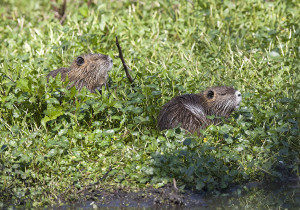What they’re taking about are nutria, dark, furry mammals with the face of a beaver and the tail of a rat.
I’ve run across a lot of them, not just in the city park, but along Buffalo Bayou and in the marsh at Brazos Bend State Park. They have distinct “hands” on their front paws that they use to grasp food, and webbed feet in the back to propel them through the water. They look a little like a cartoon character, with long white whiskers surrounding two protruding, orange buck teeth. They’re smaller than a beaver and bigger than a muskrat, and the way you can tell them apart is their long, round tail.
Each time I visit Hermann Park, there seem to be more of them, growing in extended families. If you’re feeding ducks or turtles there for any length of time, several nutria will swim toward you. Often, they clamber out of the water to see just where the food is coming from. But they appear to be nearsighted and can’t seem to find it unless it’s right under their noses.
While a lot of the families at the park see them as cute furry animals, in many people they provoke the same feelings of disgust as fire ants. In fact, they have a lot in common with that stinging menace. Like fire ants, they’re an invasive species from South America that has thrived, spread and wreaked havoc. They were first brought in by “fur farmers” in Louisiana in the 1930s as an alternative to the more expensive mink, sable and fox. Of course, a few of them escaped or were released to the wild and, well, you can guess the rest.
Until the 1980s, a relatively thriving fur market kept them in check, but as fur prices declined, their population grew exponentially. (Nutria are able to breed as little as three months after they’re born and have litters of about five. In a year, they can produce two litters with a third on the way. Do the math.)
Nutria are vegetarians with a huge appetite for marsh grasses, so much so that they have devastated tens of thousands of acres of valuable wetlands, turning them into open water. That loss of habitat translates into smaller populations of the fish, birds, crustaceans and other wildlife that breed there, while increasing the rate of coastal erosion.
When oil spills and tropical storms batter the Gulf Coast, there is an outpouring of sympathy for the Brown Pelican and other wildlife. But no tears are shed for the nutria.
“If there’s a silver lining for the Gulf Coast from Hurricane Issac, it might just be this,” wrote one NBC reporter. “The surge of water flushed out, and drowned, thousands of nutria …”
People come at the problem from different angles.
• In Louisiana, the Department of Wildlife & Fisheries pays hunters $5 per tail for them, and last year paid out almost $1.8 million for more than 350,000 of the critters.
• The sheriff in Jefferson Parish sent his SWAT team in with rifles and silencers to take down nutria along the city’s canals at night. Riding in the back of pickup trucks, shining a spotlight on the water, they pick them off one by one.
• A group called Righteous Fur touts nutria as a “stylish eco-friendly alternative to traditional fur” and argues that it is a fur you can wear with a clear conscience.
• Finally, with the philosolphy that if you can’t beat ‘em, eat ‘em, there are nine recipes for nutria on Food.com, including the “Prudhomme Family’s Nutria Chili”

You must be logged in to post a comment.